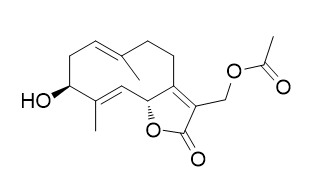13-Acetoxy-3beta-hydroxygermacra-1(10)E,4E,7(11)-trien-12,6alpha-olide
13-Acetoxy-3beta-hydroxygermacra-1(10)E,4E,7(11)-trien-12,6alpha-olide is a natural product from Artemisia myriantha.
Inquire / Order:
manager@chemfaces.com
Technical Inquiries:
service@chemfaces.com
Tel:
+86-27-84237783
Fax:
+86-27-84254680
Address:
1 Building, No. 83, CheCheng Rd., Wuhan Economic and Technological Development Zone, Wuhan, Hubei 430056, PRC
Providing storage is as stated on the product vial and the vial is kept tightly sealed, the product can be stored for up to
24 months(2-8C).
Wherever possible, you should prepare and use solutions on the same day. However, if you need to make up stock solutions in advance, we recommend that you store the solution as aliquots in tightly sealed vials at -20C. Generally, these will be useable for up to two weeks. Before use, and prior to opening the vial we recommend that you allow your product to equilibrate to room temperature for at least 1 hour.
Need more advice on solubility, usage and handling? Please email to: service@chemfaces.com
The packaging of the product may have turned upside down during transportation, resulting in the natural compounds adhering to the neck or cap of the vial. take the vial out of its packaging and gently shake to let the compounds fall to the bottom of the vial. for liquid products, centrifuge at 200-500 RPM to gather the liquid at the bottom of the vial. try to avoid loss or contamination during handling.
Molecules.2020, 25(18),4089.
Biomedicines.2020, 8(11):486.
BMC Complement Altern Med.2017, 17(1):393
Molecules.2020, 25(18):4283.
Tumour Biol.2015, 36(9):7027-34
ACS Omega2020, 5,33,20825-20830
Chem Biol Interact.2024, 398:111103.
Food Chem.2016, 191:81-90
Phytochemistry.2021, 181:112539.
J Korean Soc Food Sci Nutr2023, 52(11):1101-1110
Related and Featured Products
Phytochemistry. 2002 Mar;59(5):529-36.
Germacranolides from Artemisia myriantha and their conformation.[Pubmed:
11853748]
METHODS AND RESULTS:
The CH(2)Cl(2) extract of the aerial parts of Artemisia myriantha afforded three germacranolides derived from 13-Acetoxy-3beta-hydroxygermacra-1(10)E,4E,7(11)-trien-12,6alpha-olide, whose structures were elucidated by 2D-NMR spectroscopic analyses. Some conclusions are drawn about the possible conformations of the ten-membered germacranolide ring system from the exchange peaks seen in the NOESY spectra, and an estimate is made of the energy barrier to ring-flipping from variable-temperature NOESY experiments.
CONCLUSIONS:
The conclusions reached were supported by molecular modeling studies and an NMR spectroscopic investigation of the commercially available germacranolide, parthenolide.



